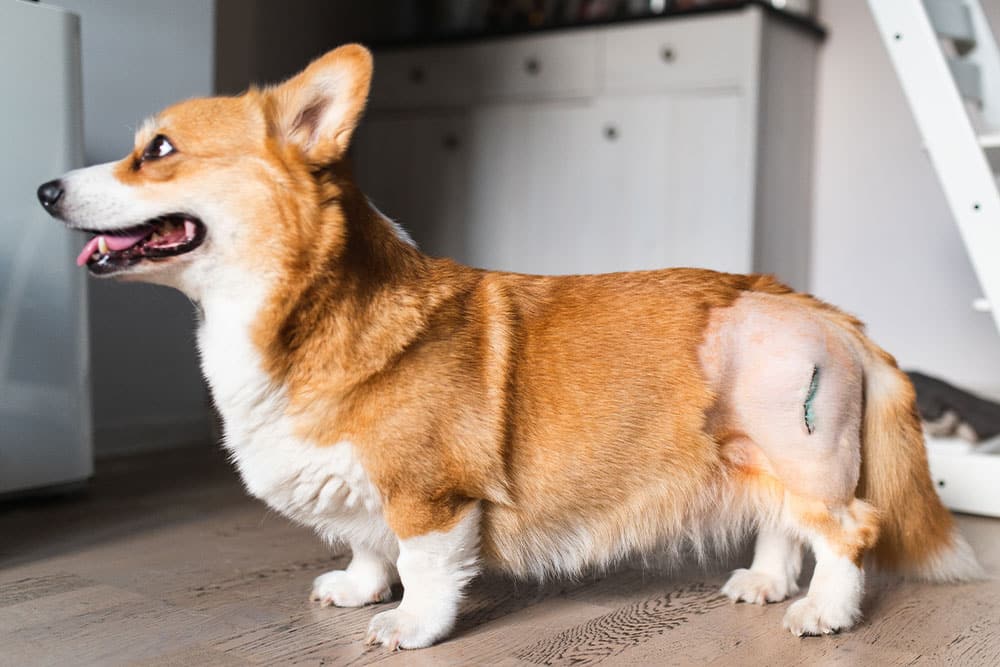What is Osteoarthritis in Pets?
Osteoarthritis, also known as degenerative joint disease (DJD), is a progressive and painful condition that affects the joints of dogs and cats. Over time, the protective cartilage between bones wears down, leading to inflammation, stiffness, and decreased mobility.
Common signs of osteoarthritis include:
- Limping or favoring a limb
- Difficulty standing up, jumping, or using stairs
- Stiffness, especially after resting
- Reluctance to exercise or play
- Visible joint swelling or sensitivity to touch
Recognizing these early warning signs is essential to providing timely veterinary care and preventing unnecessary pain. Learn more about how arthritis affects cats from iCatCare.
How Osteoarthritis Progresses
Osteoarthritis worsens over time, and without treatment, pets may experience chronic pain, loss of mobility, and reduced quality of life. In severe cases, pets may become completely inactive, leading to muscle atrophy and weight gain, which further stresses the joints.
Regular monitoring, early intervention, and customized treatment plans can slow the progression of arthritis and keep your pet active and comfortable.
Diagnosing Osteoarthritis in Dogs and Cats
Veterinarians diagnose osteoarthritis using:
- Physical Exams – Assessing joint movement, stiffness, and pain responses.
- X-rays & Imaging – Detecting cartilage loss, joint damage, or bone spurs.
- Medical History & Activity Changes – Noting reductions in movement and behavior shifts.
If you suspect your pet is showing signs of joint pain, schedule an evaluation at Spring Branch Veterinary Hospital here.
Traditional Treatments for Osteoarthritis
Medications and Supplements
Veterinary treatment may include:
- Non-Steroidal Anti-Inflammatory Drugs (NSAIDs) – Reduce inflammation and pain but require regular monitoring for side effects.
- Joint Supplements – Glucosamine, chondroitin, and omega-3 fatty acids help protect cartilage and reduce inflammation.
- Pain Relief Therapies – Some pets benefit from acupuncture, hydrotherapy, or massage therapy as part of their pain management routine.
Weight Management and Exercise
- Maintaining a healthy weight reduces excess strain on joints.
- Low-impact exercise (like swimming or controlled leash walks) helps strengthen muscles that support joint function.
- Daily mobility exercises help prevent stiffness. Check out Zoetis Petcare’s guide on arthritis-friendly exercises.
Laser Therapy for Osteoarthritis in Pets
How Laser Therapy Works
Laser therapy is a non-invasive, drug-free treatment that reduces pain and inflammation while stimulating tissue repair. Learn more about our therapy laser here. It uses low-level light energy to:
- Improve circulation and oxygen flow to damaged joints.
- Reduce swelling and stiffness.
- Increase mobility and comfort over time.
Many pets experience noticeable improvement in pain levels and movement after just a few sessions. Learn more about laser therapy from the AKC.
Comprehensive Arthritis Management Plans
At Spring Branch Veterinary Hospital, we take an integrative approach to osteoarthritis management, combining:
- Medications & Supplements – For pain control and cartilage protection.
- Laser Therapy – To improve joint mobility and reduce discomfort.
- Rehabilitation Therapy – Strengthens muscles and improves joint stability.
- Nutrition & Weight Management – Prevents excess strain on joints.
Read more about rehabilitation therapy for arthritis here.
Additional Supportive Therapies for Osteoarthritis
Hydrotherapy and Physical Therapy
Water therapy reduces joint strain while improving muscle tone and flexibility. Learn more about arthritis rehabilitation exercises here.
Home Modifications for Pets with Joint Pain
Making simple adjustments at home can significantly improve your pet’s comfort and mobility:
- Provide orthopedic bedding – Reduces pressure on sore joints.
- Use ramps or stairs – Helps pets avoid jumping up or down.
- Keep floors slip-free – Rugs and mats prevent sliding injuries.
- Warm sleeping areas – Cold weather can increase stiffness and pain.
Learn about warm-ups and cooldowns for arthritic dogs here.
Preventing Osteoarthritis in Pets
While some risk factors (aging, genetics) are unavoidable, pet owners can slow disease progression by:
- Maintaining a healthy weight – Prevents excess stress on joints.
- Providing joint-supportive diets – Omega-3s and antioxidants reduce inflammation.
- Keeping pets active – Regular low-impact movement keeps joints flexible.
- Scheduling preventive screenings – Early detection allows for proactive treatment.
Read more about preventive testing for senior pets from Zoetis Petcare here.

Frequently Asked Questions About Osteoarthritis and Laser Therapy
Q: How can I tell if my pet is in pain from osteoarthritis?
A: Watch for limping, stiffness, difficulty rising, or decreased activity levels. If your pet is reluctant to jump or play, arthritis could be the cause.
Find more signs of pet pain here.
Q: Is laser therapy safe for my pet?
A: Yes! Laser therapy is painless, non-invasive, and safe for long-term pain management. It works well alongside medications or rehabilitation therapy. Learn more about our therapy laser here.
Q: What should I do if I suspect my pet has osteoarthritis?
A: Schedule a veterinary consultation to develop a customized treatment plan.
Learn about surgical options for severe arthritis and hip dysplasia here.
Why Choose Spring Branch Veterinary Hospital for Arthritis Care?
At Spring Branch Veterinary Hospital, we focus on long-term pain management and mobility support. Our team provides:
- Advanced diagnostic tools to detect arthritis early.
- Personalized treatment plans tailored to your pet’s needs.
- Innovative pain relief therapies like laser therapy and rehabilitation.
Schedule a Consultation for Your Pet
If your pet is limping, stiff, or struggling with mobility, it’s time to take action. Our team at Spring Branch Veterinary Hospital is ready to help.
Read more about our geriatric care services to explore treatment options and give your pet a happier, more comfortable life.









Leave A Comment